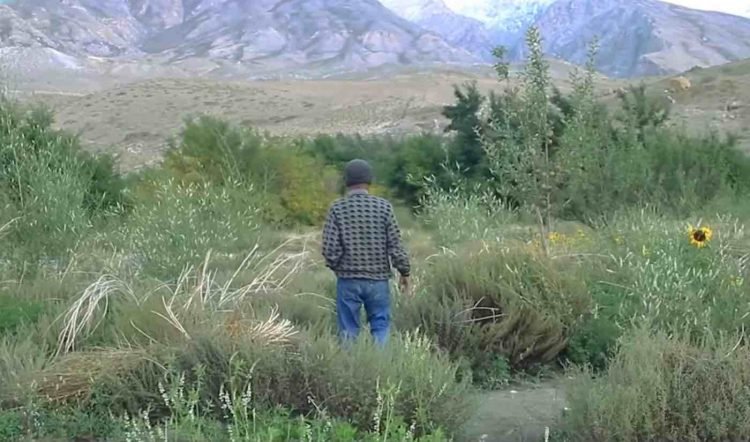
The Desert Healer – Man Spends Two Decades Creating Green Oasis in Middle of Cold Desert
Published on June 8, 2021 at 8:35 AM by Mc Noel Kasinja
Anand Dhawaj Negi, a retired bureaucrat turned desert farmer, spent over two decades of his life turning the cold wastes of northern India’s Himachal Pradesh into a vibrant oasis.
In 1977, the Indian Government kickstarted an ambitious program to mitigate the adverse effects of desertification in the Asian country’s cold and hot deserts. A. D. Negi worked in the financial department in charge of the Desert Development Program and saw millions of dollars go down the drain with no real results to show for it. Whenever he asked scientists and officials involved in the program why there was no real progress, the answer would always be that they lacked the technology to develop any type of sustainable crops in the inhospitable environment that is the desert. A farmer’s son himself, Negi grew tired of excuses and took a leave of absence in 1999 to take a crack at it himself. By 2003, he had already permanently retired from his job to concentrate all of his energy on his growing desert oasis.
A native of Sunam village in Kinnaur, Negi took it upon himself to turn a barren patch of land in the cold desert of Himachal Pradesh into a green oasis just to show everyone, particularly the struggling farmers in the area that it could be done. It wasn’t the easiest thing to do in the world, but the former bureaucrat knew what he was getting into and had the ambition and patience to see it through.
A. D. Negi’s first attempts failed, because the seeds he planted didn’t have enough water, so that was his first challenge. He employed contour planting – tilling sloped land along a consistent elevation – in order to conserve rainwater and reduce soil erosion, and worked with local communities to create shallow irrigation channels that divert streams from glaciers located about 25 kilometers away. After witnessing his progress, the regional irrigation department also started cooperating.
“The irrigation department supplies water here. Earlier, it did not make water available before June. I worked on it and supplemented their efforts. I also worked on the Kuhls, so we managed to get water supply in the months of April and May. Once we made it possible, the irrigation department also cooperated and ensured regular water supply here,” Negi told Down to Earth.
But water was just one of the challenges posed by the cold deserts. The sandy soil lacked the nutrients to sustain the crops Negi wanted to plant, so he started a farm of about 300 Chigu goats and mixed their manure with earthworms to effectively double the nitrogen content of the land. That was further boosted by the hectares of clover he planted around the oasis, which decompose regularly as new plants take their place.
The clover buffer also fixed the hare problem Negi was confronted with initially. The rodents would come to feast on the tasty plants, so the farmer planted clover of the leguminous pea family around the more valuable crops. Because the hares love clovers, they don’t bother with the other plants.
When he first began his work in Himachal Pradesh, A. D. Negi spent all of his money on testing different combinations of local farming techniques with more scientific methods of cultivation. It was a laborious process, but over time, the mortality rate of the plants went from around 85% to 1%.
After proving that valuable plants like kidney beans, potatoes, green peas, apples, and apricots could be grown even in the harsh desert environment, the former bureaucrat began focusing on trees, as he considered them essential for combatting climate change in the region.
“My first priority here is afforestation,” the Desert Healer said. “Robinia trees are the highest in number. They are followed by willow poplar and wild apricot trees. As far as fruit trees and other crops including green peas are concerned, I grow them just for demonstration purposes so that people can replicate them.”
With the help of just two volunteers, Anand Dhawaj Negi managed to turn a patch of over 90 hectares of cold desert into a green oasis that attracted the praise of both locals and scientists. People come from far and wide to witness this real-life miracle, some come to buy Negi’s natural fertilizer to grow their own crops, and others bring their cattle to graze on his clover, as it is considered the best fodder in the region.
Sadly, Anand Dhawaj Negi, the Desert Healer, passed away last month, at the age of 74, after suffering a stroke. He will be remembered as a local hero and his green oasis will hopefully be preserved as a reminder that nothing is impossible. Negi’s family plan to continue his work, but have asked the government to assume responsibility for the oasis and help with its preservation.
“Before he bade goodbye to us, he was planning to plant some evergreen or coniferous trees like pine and deodar,” Virender Sappa Negi told The Better India. “Now, as a family, we want to fulfill his last wishes. Also, we want the state government to take responsibility for his forest so that his work can inspire future generations.”
Anand Dhawaj Negi joins other Indian legends who dedicated their lives to reforestation, such as the Tree Man of Uttarakhan, or Aditya and Poonam Singh.


